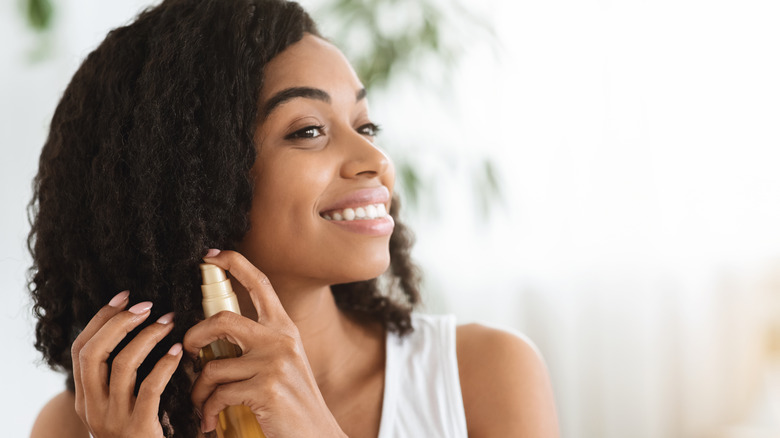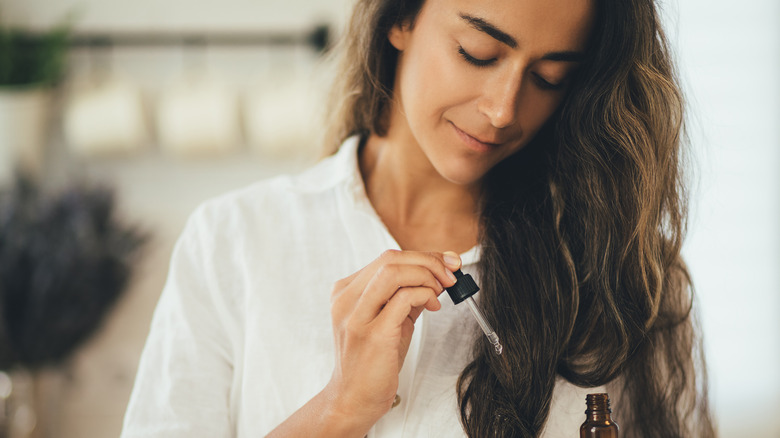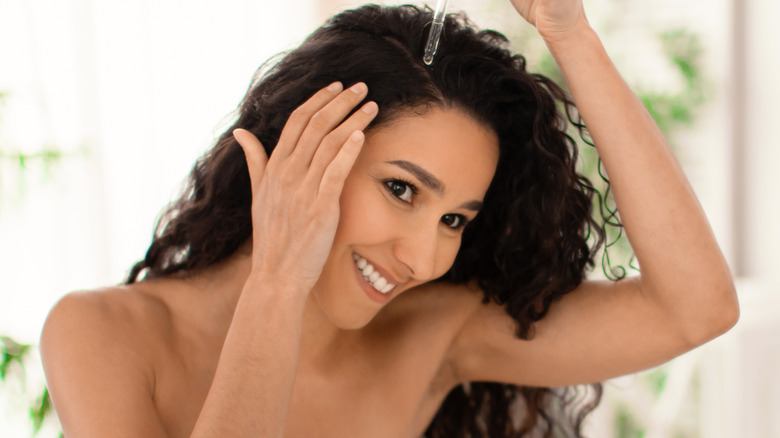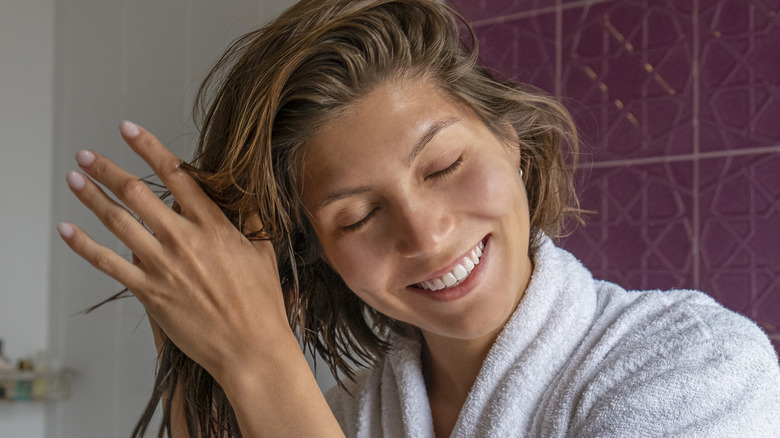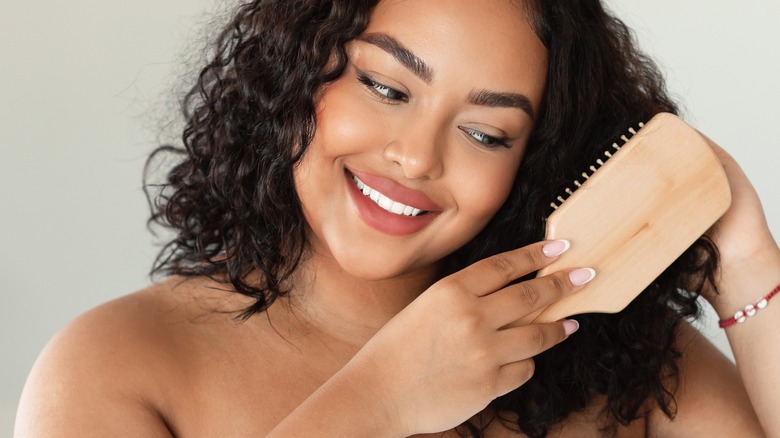Hair Product Cocktailing Is The Key To Frizz-Free Summer Looks
Although lifestyle habits like heat styling are chiefly responsible for unruly flyaways and baby hairs, hot and humid weather can also put your hair at a greater risk of frizz. That's probably why bad hair days peak during summertime when humidity levels are at an all-time high. Humidity affects all hair types, but more so in dry hair. When your hair is dehydrated, it will jump at the chance to sponge up the moisture in the air to satisfy its thirst and turns into a frizzy mess as a result. That's why keeping your hair sufficiently hydrated is the key to battling humidity-induced frizz.
There are various ways to keep your hair moisturized, such as hair oiling or using hydrating shampoo. But if you want to triple-hack the humidity, you should go the extra mile and use cocktailing, a hair care technique used for frizz control by hair care professionals for decades. If you've been trying various anti-frizz solutions to no avail, perhaps it's time you started trying this trick of the trade for silky smooth tresses all summer.
What is hair cocktailing?
In the world of hair care, cocktailing simply means mixing a couple of hair products and emulsifying them to create the ultimate mash-up that helps you achieve your hair goals. It's like combining different alcoholic drinks to make a cocktail. "It's a great choice for curls because you're able to address each need by making one ultimate concoction," celebrity hairstylist Alexander Armand tells The Zoe Report. According to Armand, cocktailing can be a real game changer for natural, curly, or coily hair types, giving those tresses an extra boost of moisture and hold to reach their full potential.
There's no limit to what you can throw into your mixer as long as the ingredients are compatible and non-reactive (i.e., conditioners, shampoo, and styling products.) Depending on your hair needs, you can make a mix of leave-in conditioner, curl cream, and anti-frizz serum to boost hydration while defining curls and taming frizz if those are your main concerns. Or, you can mix a few drops of root-lifting hair oil with some anti-frizz styling mousse to keep your hair bouncy and un-poufy all day. The possibilities are endless.
However, if you're new to cocktailing, it's better, to begin with a small amount of easy styling products and gradually work your way up. You'll never know which formula strikes your fancy until you try it, so keep experimenting until you reach a desired combination for your hair.
How to create a hair cocktail
Cocktailing is an art and typically has its ideal balance of ingredients which we commonly refer to as the golden ratio. When it comes to hair, however, the ratio depends largely on your hair type, hair length, and hair density, so there are no hard-and-fast rules for cocktailing. You'll have to play your own chemist and hamster to know what works for you.
Humidity can dry your hair, so you might want to bring out the most hydrating hair products. If your goal is hydration, hair experts recommend mixing a moisturizing shampoo with a deep conditioner and applying the mixture to your hair twice a month. Curly hair is prone to dryness and frizz during warmer months. A cocktailing treatment is especially helpful in hydrating and nourishing the hair shaft, making it softer and more manageable. To amplify and define your curls, make a cocktail of a volumizing hair mousse, a leave-in conditioner, and a curl-defining cream. This combination gives your locks a boost of moisture alongside extra volume and hold.
If you don't have ample knowledge about chemicals or cocktailing, it's best to stick to products from the same brand. "Products from the same brand are typically formulated to work in unison together; therefore, you have less risk of flaking or residue when sticking to products from the same brand," Madison Sullivan, L'Oréal Professionnel artist and Hair.com ambassador, tells Hair.com by L'Oreal.
Can you mix hair conditioners together?
Conditioners are known for making our hair buttery soft, and smooth, so it's tempting to mix different conditioners to maximize its effect. For instance, if you have a curl-defining conditioner and a regular moisture-enhancing conditioner, should you combine them? You can, but you should be very careful about it.
Conditioners are not created equal. Natural conditioners are safer to mix and match because they don't contain synthetic chemicals. Chemical-based conditioners, on the other hand, might contain chemicals that clash and yield adverse reactions when combined. Conditioners differ in their formulation, including their ingredients and pH levels. If you mix hair conditioners that are not compatible, you risk damaging your hair color or even causing an allergic reaction to your scalp. The same can be said for shampoos.
What's most concerning about chemical-based conditioners is that some contain silicone, a lubricating substance that gives post-conditioned hair its slippery, detangled effect. Silicone can have a long-term detrimental impact on the health of your hair, so avoid cocktailing silicone-based conditioners. Experts recommend cocktailing hair conditioners only as a last resort and sticking to natural products if you can. If you want to give it a shot, you can consult your hair stylist first to make sure your "cond-tail" is risk-free.
Which is better: layering or cocktailing?
Both layering and cocktailing involve multiple hair products, but they are not the same concept. "Layering products on means applying one product at a time but using multiple products to style the hair," Madison Sullivan tells Hair.com by L'Oreal. "Some products will specify if they are meant to be cocktailed or layered in. If not, this is where the experimenting and trial and error comes into play again," Sullivan continued.
Depending on individual hair conditions, some people might benefit from layering, while others might see improvements with cocktailing. Layering allows better product application control and is especially effective on thick and dry hair types. However, layering might take longer because you have to wait for each product layer to dry before building on it.
Cocktailing, on the other hand, gives you more flexibility as you can decide what to throw into the mix and what not, depending on what your hair needs on that particular day. Maybe a little less coconut oil and more anti-frizz spray and volumizing serum. Nonetheless, cocktailing is all about experimenting, and unless you have a solid grasp of hair products, most experiments will be hit-or-miss. Each of these techniques has its merits and demerits. You'll have to try both to know what works best for you.
How to work the cocktail into your hair
When it comes to hair cocktailing, you don't need a mixer or a bowl to pour the blend into. You can add a tiny amount of each styling product into your hand, emulsify them, and apply the mixture directly to your hair, as usual with regular styling products. To avoid build-up on your scalp, work the mix into the ends and the mid-lengths and concentrate on the parts that need the most hydration boost. Then, use a comb or your fingers to distribute the mixture evenly down the lengths.
Aside from cocktailing, other methods might help with seasonal frizz. To lessen pesky flyaways, wash your hair with cool instead of hot water because cold water closes the hair cuticles, preventing frizz. Getting a regular haircut is also an effective way to eliminate split ends and nip unruly baby hairs in the bud. Sun damage can also manifest in frizziness, so sunproof your hair with SPF before going out. Whether you're cocktailing or not, coating your hair and scalp with sunblock is still your hair health's best line of defense against sun damage. It also helps to keep your cocktailing efforts from going down the drain.
